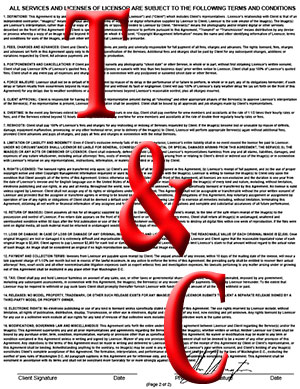Diversification and A Variety of Clients
 Each week, my subscription to BusinessWeek
Each week, my subscription to BusinessWeek arrives and I look forward to reading it. Yes, yes, there are many articles which don't apply to me, but I do appreciate keeping up with other fields, and I really enjoy seeing the work my colleagues produce for this publication, and I've had an assignment or two grace their pages, and, quite importantly, they have a very fair contract for their photographic contributors. For less than $1 a week, you too can get this collection of insights delivered to your doorstep.
But, that's not why I write. It's because of a really great message that resonates with what I've been trying to say for some time. In today's mail my Business Week arrived, and in Jack and Suzy Welch's column, Ideas The Welch Way (he, legendarily formerly of GE), responds to a question which posits:
"Companies let go of troublesome employees. Is it ever a good idea to apply the same practice to troublesome customers?"In part, they respond:
"...there are some circumstances where the old adage about customer supremacy can actually be destructive, and it makes sense to say no or even goodbye....when a customer's demand for price destroys your profitablility, or worse, creates industry pricing chaos, that's when you have to hold the line and dump the customer...now, sometimes your big customers...they own you, and they know it. So with them, you may need to endure...outrageous demands."Sound familiar? Are you a diversified photographer who has many clients in multiple arenas, or just a few big ones? How about clients making outrageous demands? If you're not diversified, you feel you must put up with them, and it often seems like a spiral that you can never escape.
Dumping the bad clients, and embracing the best, turning away the bad deals, and celebrating the good. I know, I know...I hear the refrain "but I'm new to business, how do I get these clients?" Well, frankly, one at a time, and initially, they are few and far between. Why? Because the "best" clients, with "good" deals, have photographers they call upon. They don't know who you are, or that you exist. They only look for another photographer when theirs is not available. And, in the meantime, the deals that others are turning away are coming to you. I know it takes awhile, but like any good thing, it takes awhile to come around.
BusinessWeek
Please post your comments by clicking the link below. If you've got questions, please pose them in our Photo Business Forum Flickr Group Discussion Threads.
 If you're a Pablo Picasso, and your work has sold for millions, and you donate a work to charity, you may only donate the cost of the canvas and oils. Sad, but true.
If you're a Pablo Picasso, and your work has sold for millions, and you donate a work to charity, you may only donate the cost of the canvas and oils. Sad, but true. The Associated Press is reporting that "Two Missouri lawmakers are challenging a National Football League policy prohibiting local television stations from covering games on the sidelines...Legislation filed Tuesday would force the NFL to allow local TV cameras on the sidelines of games hosted by the Kansas City Chiefs and St. Louis Rams, both of whom play in publicly subsidized stadiums. Media denied reasonable sideline access could sue for damages. Since a Missouri law cannot overturn a nationwide NFL policy, the bill focuses solely on the two stadiums in Missouri. It says that any entity owning, operating or leasing a stadium for which at least 10 percent of the construction costs came from state or local taxes cannot prohibit media photographers from having reasonable access to the sidelines of the playing field."
The Associated Press is reporting that "Two Missouri lawmakers are challenging a National Football League policy prohibiting local television stations from covering games on the sidelines...Legislation filed Tuesday would force the NFL to allow local TV cameras on the sidelines of games hosted by the Kansas City Chiefs and St. Louis Rams, both of whom play in publicly subsidized stadiums. Media denied reasonable sideline access could sue for damages. Since a Missouri law cannot overturn a nationwide NFL policy, the bill focuses solely on the two stadiums in Missouri. It says that any entity owning, operating or leasing a stadium for which at least 10 percent of the construction costs came from state or local taxes cannot prohibit media photographers from having reasonable access to the sidelines of the playing field." First things first: the page title. Here it is:
First things first: the page title. Here it is:

 BULLSHIFT! Everyone's afraid to talk prices. Everyone says "oh, we can't talk prices because of anti-trust laws." Again, I say, BULLSHIFT! Wikipedia has a pretty decent outline of price-fixing:
BULLSHIFT! Everyone's afraid to talk prices. Everyone says "oh, we can't talk prices because of anti-trust laws." Again, I say, BULLSHIFT! Wikipedia has a pretty decent outline of price-fixing: Excerpted from Their Article
Excerpted from Their Article I became aware of a
I became aware of a  So, the folks who are inspired to make and (essentially) give away their work for the joy of seeing their work out in the world are up in arms because people are further spreading their (supposedly) royalty-free work beyond where they were expecting. This
So, the folks who are inspired to make and (essentially) give away their work for the joy of seeing their work out in the world are up in arms because people are further spreading their (supposedly) royalty-free work beyond where they were expecting. This  When you're not home, your voicemail is the only - and initial - interaction that your prospective client will have with you. Making sure that it is a professional and positive experience can easily mean the difference between a prospective client leaving a message and their hanging up. To that end, make sure your voicemail on the landline and on your cell phone are complimentary, written down, and practiced, and sound professional. When recording it, do so in a quiet room.
When you're not home, your voicemail is the only - and initial - interaction that your prospective client will have with you. Making sure that it is a professional and positive experience can easily mean the difference between a prospective client leaving a message and their hanging up. To that end, make sure your voicemail on the landline and on your cell phone are complimentary, written down, and practiced, and sound professional. When recording it, do so in a quiet room.  So, the models are the latest to feel the squeeze. In the February 3-4 edition of the Wall Street Journal Weekend Edition
So, the models are the latest to feel the squeeze. In the February 3-4 edition of the Wall Street Journal Weekend Edition 